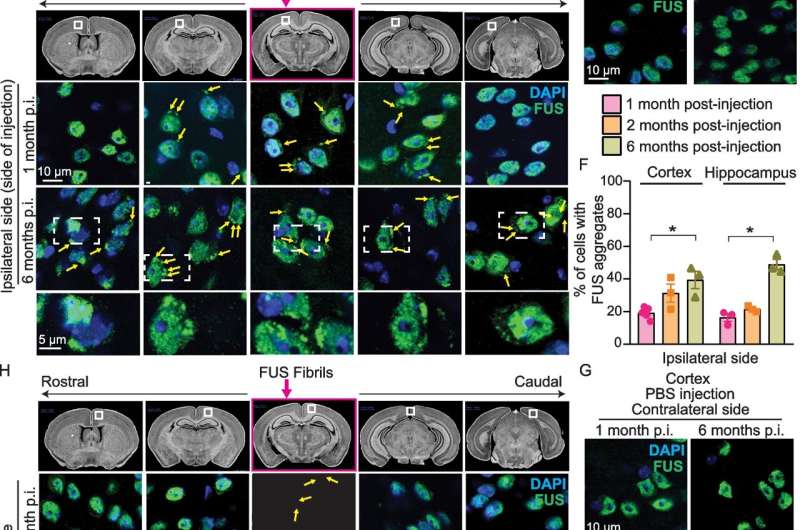This article has been reviewed according to Science X's editorial process and policies. Editors have highlighted the following attributes while ensuring the content's credibility:
fact-checked
peer-reviewed publication
trusted source
proofread
Study reveals FUS protein's role in two neurodegenerative diseases

Frontotemporal dementia (FTD) and amyotrophic lateral sclerosis (ALS) are two devastating neurodegenerative diseases. Scientists have long suspected a protein called FUS might play a role, but the exact mechanism remained a mystery.
A new study by the lab of Prof. Sandrine Da Cruz published in Molecular Neurodegeneration reveals how the FUS protein behaves in these diseases, which is crucial for potential therapeutic interventions.
Frontotemporal dementia (FTD) is a form of early-onset dementia, accounting for approximately 10–20% of dementia cases. Unlike Alzheimer's disease, which primarily affects memory, FTD is characterized by changes in personality, behavior, and language due to degeneration in the frontal and temporal lobes of the brain.
Amyotrophic lateral sclerosis (ALS), the most common degenerative motor neuron disease in adults, is characterized by a selective loss of motor neurons, resulting in progressive muscle weakness and paralysis, as well as swallowing and speech difficulties. Patients usually succumb to the disease within two to five years after diagnosis. Every year, around 100,000 people die of ALS.
In both these diseases, a protein called "fused in sarcoma" (FUS) causes problems. Normally, FUS resides mostly in the cell's nucleus, but in some patients, it clumps together (aggregates) in the cytoplasm.
A new study, led by Prof. Sandrine Da Cruz at the VIB-KU Leuven Center for Brain & Disease Research, reveals how these FUS aggregates spread and behave, contributing to neurodegeneration.
Spreading the disease
The researchers injected disease-associated human FUS aggregates into mice engineered to express human FUS protein. Remarkably, the aggregates acted like seeds, causing the endogenous human FUS protein in the mice to aggregate and spread to other regions of the brain.
"This finding suggests a prion-like mechanism, which is a process where proteins misfold and cause other proteins to misfold in a similar way, leading to the spread of disease within a body," says Dr. Sonia Vazquez-Sanchez, co-first author of the study. "In this case, misfolded FUS aggregates 'corrupt' healthy FUS proteins, which leads to a domino effect of detrimental FUS aggregation throughout the brain."
The aggregation of FUS proteins exacerbated age-dependent cognitive decline and behavioral deficits in the mice. This process mirrors what is observed in human FTD and ALS, where protein aggregates spread and contribute to neurodegeneration.
Another important discovery was the species barrier to FUS aggregation. When human FUS fibrils were injected into mice, which express only mouse FUS, no aggregation occurred. This indicates that specific interactions between human FUS proteins may be necessary for the aggregation and spread.
Implications and future directions
This research supports the broader hypothesis that many neurodegenerative diseases, including Alzheimer's and Parkinson's, may involve prion-like mechanisms where misfolded proteins propagate by inducing similar misfolding in normal proteins. Understanding these mechanisms opens new avenues for therapeutic strategies aimed at halting or slowing disease progression by targeting the spread of protein aggregates.
The research team is currently investigating the specifics of FUS aggregate-induced neurodegeneration. "Identifying the exact components of these aggregates and the brain regions most affected by their spread will be crucial for developing future therapeutic interventions," concludes Prof. Sandrine Da Cruz.
More information: Sonia Vazquez-Sanchez et al, Frontotemporal dementia-like disease progression elicited by seeded aggregation and spread of FUS, Molecular Neurodegeneration (2024). DOI: 10.1186/s13024-024-00737-5





















